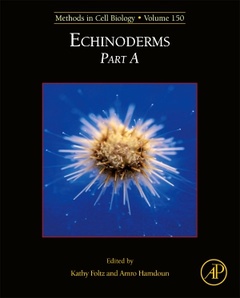Echinoderms

Echinoderms, Volume 150 in the Methods in Cell Biology series, highlights new advances in the field, with this update presenting interesting chapters on procuring animals and culturing of eggs and embryos, cryopreservation of sea urchin gametes, emerging echinoderm models, culturing of sand dollars, cidaroids and heart urchins, culturing echinoderm larvae through metamorphosis, microinjection methods, injection of exogenous messages and protein overexpression, blastomere transplantation, visualization of embryonic polarity, larval immune cell approaches, methods for analysis of sea urchin primordial germ cells, and protocols and best practices for toxicology and pH studies using echinoderms and several new chapters outlining the use of sea urchins in the classroom.
Section 1 Procurement and culturing of established and emerging echinoderm models 1. Procuring animals and culturing of eggs and embryos Nikki L. Adams, Andreas Heyland, Linda L. Rice and Kathy R. Foltz 2. Cryopreservation of sea urchin sperm and early life stages Estafania Paredes, Serean L. Adams and Julien Vignier 3. Temnopleurus as an emerging echinoderm model Shunsuke Yaguchi 4. Cidaroids, clypeasteroids, and spatangoids: Procurement, culture, and basic methods Taku Hibino, Takuya Minokawa and Atsuko Yamazaki 5. The painted sea urchin, Lytechinus pictus, as a genetically-enabled developmental model Katherine T. Nesbit, Travis Fleming, Grant Batzel, Amara Pouv, Hannah Rosenblatt, Douglas A. Pace, Amro Hamdoun and Deirdre C. Lyons 6. Culturing echinoderm larvae through metamorphosis Jason Hodin, Andreas Heyland, Annie Mercier, Bruno Pernet, David L. Cohen, Jean-François Hamel, Jonathan D. Allen, Justin S. McAlister, Maria Byrne, Paula Cisternas and Sophie B. George
Section 2 Experimental embryology approaches 7. Microinjection methods for sea urchin eggs and blastomeres Junko Yaguchi 8. Microinjection of oocytes and embryos with synthetic mRNA encoding molecular probes George von Dassow, Jenna Valley and Kara Robbins 9. Methods for transplantation of sea urchin blastomeres Andrew N. George and David R. McClay 10. Sea urchin embryonic cilia Robert L. Morris and Victor D. Vacquier 11. Visualizing egg and embryonic polarity Lauren T. Smith and Athula H. Wikramanayake 12. Methods to label, isolate, and image sea urchin small micromeres, the primordial germ cells (PGCs) Joseph P. Campanale, Amro Hamdoun, Gary M. Wessel, Yi-Hsien Su and Nathalie Oulhen 13. Culture of and experiments with sea urchin embryo primary mesenchyme cells Bradley Moreno, Allessandra DiCorato, Alexander Park, Kellen Mobilia, Regina Knapp, Reiner Bleher, Charlene Wilke, Keith Alvares and Derk Joester
Section 3 Approaches for assessing environmental influences on adults and embryos 14. Analysis of immune response in the sea urchin larva Katherine M. Buckley, Nicholas W. Schuh, Andreas Heyland and Jonathan P. Rast 15. Methods for collection, handling, and analysis of sea urchin coelomocytes L. Courtney Smith, Teresa S. Hawley, John H. Henson, Audrey J. Majeske, Matan Oren and Benyamin Rosental 16. Measurement of feeding rates, respiration, and pH regulatory processes in the light of ocean acidification research Meike Stumpp, Sam Dupont and Marian Y. Hu 17. Methods for toxicology studies in echinoderm embryos and larvae Cristina Torres-Duarte, Carol A. Vines, Elise Fairbairn and Gary N. Cherr
Section 4 Sea urchins in the classroom 18. A teaching laboratory on the activation of xenobiotic transporters at fertilization of sea urchins Lauren E. Shipp, Rose Z. Hill and Amro Hamdoun 19. Exploring the sea urchin genome with undergraduates using bioinformatic tools Laura Romano, Christine Byrum, Pei Yun Lee and Robert Morris 20. Analyzing gene expression in sea star eggs and embryos using bioinformatics Lauren Bates, Emily Wiseman and David J. Carroll
New research scholars who wish to learn the echinoderms as a model system will find this book invaluable and for those already in the field, it will serve as a handy resource for the teaching and research laboratory.
- Clear, concise protocols provided by experts who have established the echinoderms as a model system
- Highlights new advances in the field, with this update presenting interesting chapters on echinoderms
Date de parution : 02-2019
Ouvrage de 504 p.
19x23.3 cm



